Wellbeing starts with equine-focused spaces and routines
What is an enriched environment for horses? What’s the difference between environmental enrichment and enrichment items? And where do horse toys and “boredom busters” fit into the picture? In this article we’ll look at the difference between enriched spaces and the environments used in conventional horse keeping, and how to identify how well your horse’s space meets their mental and physical needs.
Recap: What is Enrichment for Horses?
To talk about enriched environments for horses, we need to know what enrichment is, and why enriched spaces are so important.
Enrichment is anything we do or provide that encourages an animal’s natural behaviors. In other words, it’s the items, activities, or even “furniture” that gets horses acting and thinking in uniquely equine ways.
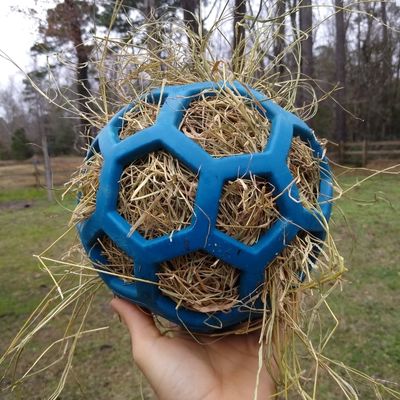
This means that enrichment isn’t just colorful stall toys or boredom busting items. It can be structures that promote self-care (like DIY scratching surfaces) or sensory items that provide variety and stimulation (like scented sensory boards).
Enriched environments for horses are ones that have been purpose-designed to encourage natural behaviors. In addition to being safe and efficient spaces, they include natural and human-made enrichment features.
For a deeper dive into what enrichment is (and isn’t), this article is the best place to start.
Why is Enrichment Necessary?
Enrichment is crucially important because horses still have the mental and physical needs of their wild ancestors. We’ve taken the horse out of the wild by domesticating them, and this comes with a lot of perks for horses.
On the other hand, a lot of traditional or conventional horse keeping doesn’t address horses’ behavioral needs. It’s normal in many regions and disciplines to keep horses alone, in confinement, or in bare spaces – in environments that are not enriched, or even “species appropriate” for horses.
Enriched environments for horses are a must to provide good wellbeing. But beyond knowing that your horse’s physical and mental needs are met, better welfare for horses comes with real benefits:
- Improved behavioral health, including reduced anxiety and aggression
- Reduction in unwanted behaviors, stereotypies, compulsions, and vices
- Better gastrointestinal health
- Improved body condition
- Safer handling and even safer rides (really – see this study)

This article contains more information on why enrichment matters.
What Are the Benefits of Enriched Environments?
In an enriched environment, the space does most of the work of encouraging behavior.
Enrichment items by themselves offer a behavioral benefit. They’re always good for horses, and in situations like stall rest, they’re the only available option.
But using only boredom busters, or toys, for horses is very labor-intensive. It’s usually possible to encourage most behaviors through standard enrichment items, but doing so for a stable of horses every day is not realistic for most equestrians.
An enriched environment provides a high quality of life and species-appropriate living – with a fraction of the day to day upkeep and labor.
Most of the work in creating an enriched environment for horses comes at the beginning, by constructing permanent changes or additions to the space. Then, boredom relief is as easy as turning your horse out with friends in their enriched environment.
In a pasture with lots of environmental enrichment, providing a varied and rich day to day experience is simple. Time and effort can be spent on fun and cognitively stimulating enrichment activities like puzzle feeders.
What Does an Enriched Environment for Horses Look Like?
An enriched environment is a space that allows horses to engage in healthy activity and make choices about where to be and what to do.
This article covers enriched outdoor spaces for horses, not stalls – because even though stalls must be used occasionally for medical purposes, stall confinement of healthy horses is a care style that cannot meet horses’ long term physical and mental needs.
An enriched space for horses and other equines usually features plenty of room to move, though smaller paddocks can encourage movement with creative use of structure. Both conventional pastures and track paddocks (shown below) can provide an enriched environment.
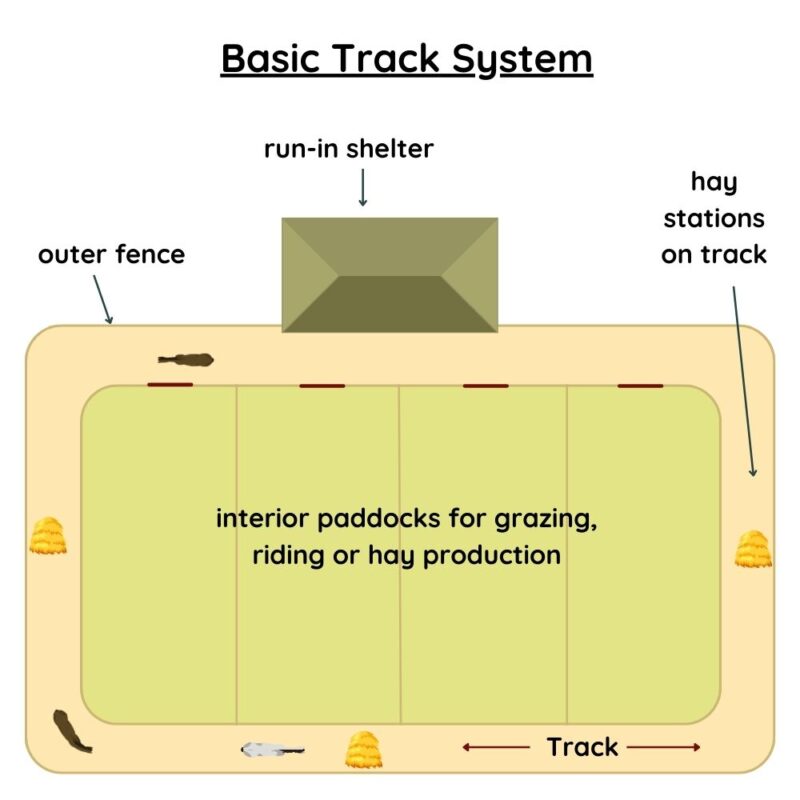
The enriched space provides ample opportunity for grazing throughout the day and night. Horses require a near-constant trickle of forage through the gastrointestinal system for best health. For spaces without grass, or horses on managed diets, this can mean stations with slow feeders containing hay (like the humble hay net) or timed feeders.
Enriched environments provide water and shelter, but may offer more than the standard run-in or water trough. There may be multiple shelter options available, or natural cover such as trees or hedges. Water may be provided in varying locations or with natural ponds.
An enriched environment also contains sensory and self-care opportunities, like scratching locations, mud wallows, or objects that encourage play.
With all these features, plus temporary toys and puzzles, an enriched environment for horses looks very different than a featureless, manicured paddock – and that’s the point!

Enriched Environments Support Horse Behavior
The key to providing an enriched environment is to make natural behavior possible. This includes foraging, socializing (no enriched paddock is complete without other horses!) and movement.
In addition to promoting these three major needs (also known as the 3 Fs – freedom, forage, and friends), an enriched environment also encourages exploration, using all the senses including space awareness and balance, and self-care activities like sleeping and grooming.

The variety of experiences available in an enriched environment produces both stimulation and change. Exposure to novelty is uncommon in traditional horsekeeping environments, where the routine and physical space usually stays the same every day. But variety and stimulation is good for horses, and is closer to the ever-changing wild environment in which they evolved.
Enriched Environments Offer Choice and Control
Creating an enriched environment for horses means maximizing their ability to choose what to do and where to be. Agency, independence and the ability to regulate physical and mental needs is one of the biggest reasons to provide an enriched space for your horse.
Let’s take a look at a standard stable design – a barn surrounded by individual turnout paddocks. This is a conventional, not enriched environment:
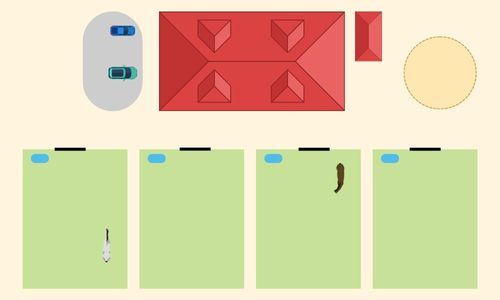
The paddocks are separated from the barn, so the horses are led from stall to turnout. The paddocks are also separated from each other, so the horses cannot choose to interact with each other. There are also no features inside the paddocks that might offer options.
An enriched environment goes above and beyond a basic turnout space by intentionally creating options for behavior. This is usually accomplished by providing resource stations or enrichment equipment that encourages similar behaviors in different ways.
For example, instead of offering hay in a single location each day, a caregiver may place hay nets in a different spot at each feeding, or offer forage at each end of the paddock space. Shelters may contain varying levels of cover, from a full windbreak shed to a small stand of bushes, so that horses can choose how to use their space.
Enriched Environments Are Complex
Part of what makes an enriched pasture so good for horses is natural complexity and texture in the environment.
This means the layout and grade of the land may change, such as when you choose to include a hillside when fencing a pasture instead of sticking to the flat land beneath.
It also includes trees, shrubs, and different species and heights of grass, as well as different substrates like stones, sand, or even mud (which isn’t always bad for horses).

No pasture can include all possible natural features, so adding texture and complexity to the space is part of creating an enriched environment for horses. This adds back the sensory input that their bodies and minds need, and gives them more options for behaviors like exploration and play.
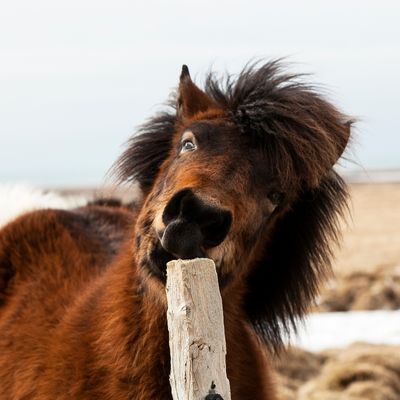
Permanent or semi-permanent structures like mud wallows, artificial hills or ponds, large logs, or even ground poles and barrels are all good ways to make the turnout space more complex.
Size, Shape, and Layout of Enriched Environments for Horses
Any size turnout space can be enriched by adding the features covered above. Bigger is better, of course, but even a smaller area can offer a lot of options with the right additions.
An irregularly shaped pasture offers room for creativity, but square or rectangular paddocks make great enriched spaces – just make sure to place resources and enrichment equipment throughout the area, making use of all corners and sides.
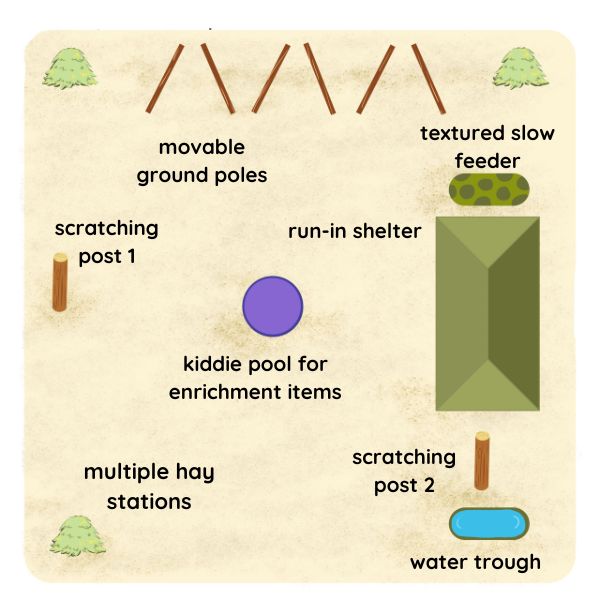
Environmental Enrichment for Horses: Good Foundations
With an enriched pasture space, the environment does the work of encouraging behavior for the most part.
This frees you up to offer extra enrichment items and activities that make your horse’s life even better each day, like toys for play or equine puzzle feeders.
It also takes less time and labor to manage enriched environments once they’re installed. You’ll need to do regular maintenance on structures and features like scratch stations or sand pits, but no more than taking care of a standard, non-enriched space.
Need ideas for outdoor enrichment? Add these to your enriched paddock space:
DIY Scratching Post for Horses: 5 Ideas for the Perfect Texture
Browse Boards for Horse Enrichment